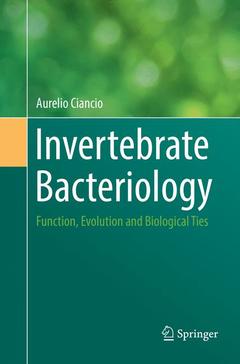SECTION I - STRUCTURE AND GENERAL PROCESSES
I The Bacterial Cell
1 Introduction
2 Structure and Functioning
2.1 The cell wall
2.2 Secretion Systems (SS)
2.3 Cytoskeleton
2.4 Chromosome and Plasmids
2.5 Flagella and Pili
2.6 Quorum Sensing
2.6 CRISPR-CAS System
3 Metabolism
4 Identification
II Bacteria and Eukaryotes Evolution
1 Introduction
2 Evolutionary Processes
3 Bacterial Diversity
4 Eukaryota and Metazoa Evolution
3 Symbiotic Relationships
1 Introduction
2 Symbiosis and Evolution
2.1 The Age of Symbiotic Associations
2.2 Endosymbiosis
2.3 Ectosymbionts (epibionts)
3 Functionality of symbiosis
3.1 Specificity
3.2 Acquisition
3.3 Benefits of Symbiosis
4 Adaptive Processes
4.1 Reproductive Manipulation
4.2 Host Adaptive Changes
4.3 Genome reduction
4 Parasitic Endosymbionts
1 Introduction
2 Parasitism Evolution
2.1 Red Queen Model
2.2 Genetic Races and Coevolution
3 Host-parasite Interactions
3.1 Environmental Factors
3.2 Resistance
3.3. Toxins
4 Diseases
4.1. Pathogenicity and Virulence
4.2 Specificity
4.3 Examples of Invertebrate Diseases
5 Travelling Bacteria: Vectors
<1 Introduction
2 Disease Transmission
2.1 Human diseases
2.2 Animal Diseases
6 Travelling Bacteria: Phoresy
1 Introduction
2 Insect-Associated Bacteria
3 Other Invertebrate Bacteria
3.1 Slug Parasitic Nematodes
3.2 Grass Gall Nematodes
3.3 Microbiovorous Nematodes
3.4 Anellids
SECTION II - MOLECULAR PROCESSES
<7 Defense and Immune Systems
1 Introduction
2 Origins and Evolution
3 Humoral defense
3.1 Melanization and Phenoloxidase Activity
3.2 Receptors and Recognition
3.3 Lectin-Mediated Complement and Activation
3.4 Antimicrobial Peptides (AMPs)
3.5 Heat shock proteins (HSPs)
3.6 Nitric Oxide (NO) and Reactive Oxygen Species (ROS)
3.7 Lysozyme and other Pathways
4 Cellular Defense Processes
4.1. Phagocytosis
4.2. Encapsulation and Hemolymph Coagulation
5 Selectivity, Specificity and Evasion
8 Horizontal Gene Transfer
1 Introduction
2 Evolutionary Benefits
2.1 Transferred Gene Categories
2.2 Acquisition and Insertion Mechanisms
2.3 Selection and Expression
3 HGT Dimensions
3.1 HGT Prevalence
3.2 Large Genome Insertions
9 The -omics race
1 Introduction
2 Genomics
2.1 Organization
2.2 Genome Analysis Tools
2.3 Recombination
2.4 Genome Reductionism
3 Other –Omics
3.1 Metagenomics<
3.2 Metatranscriptomics
3.3 Metabolomics and Proteomics
SECTION III - APPLIED APPROACHES
10 Applications in Farming
1 Introduction
2 Applied Aspects
2.1 Crops
2.2 Aquatic Industries
3 Regulation
3.1 Biological Control and Management
3.2 Regulation mechanisms
4 GM Crops
11 Environmental Interactions
1 Introduction
2 Effects on Ecosystem Services
2.1 Invertebrate Services
2.2 Heavy Metals Pollution
2.3 Pesticides
<2.4 Oil Spills
3 Climate Changes
3.1 Effects on Diseases
3.2 Environmental Effects
Index





